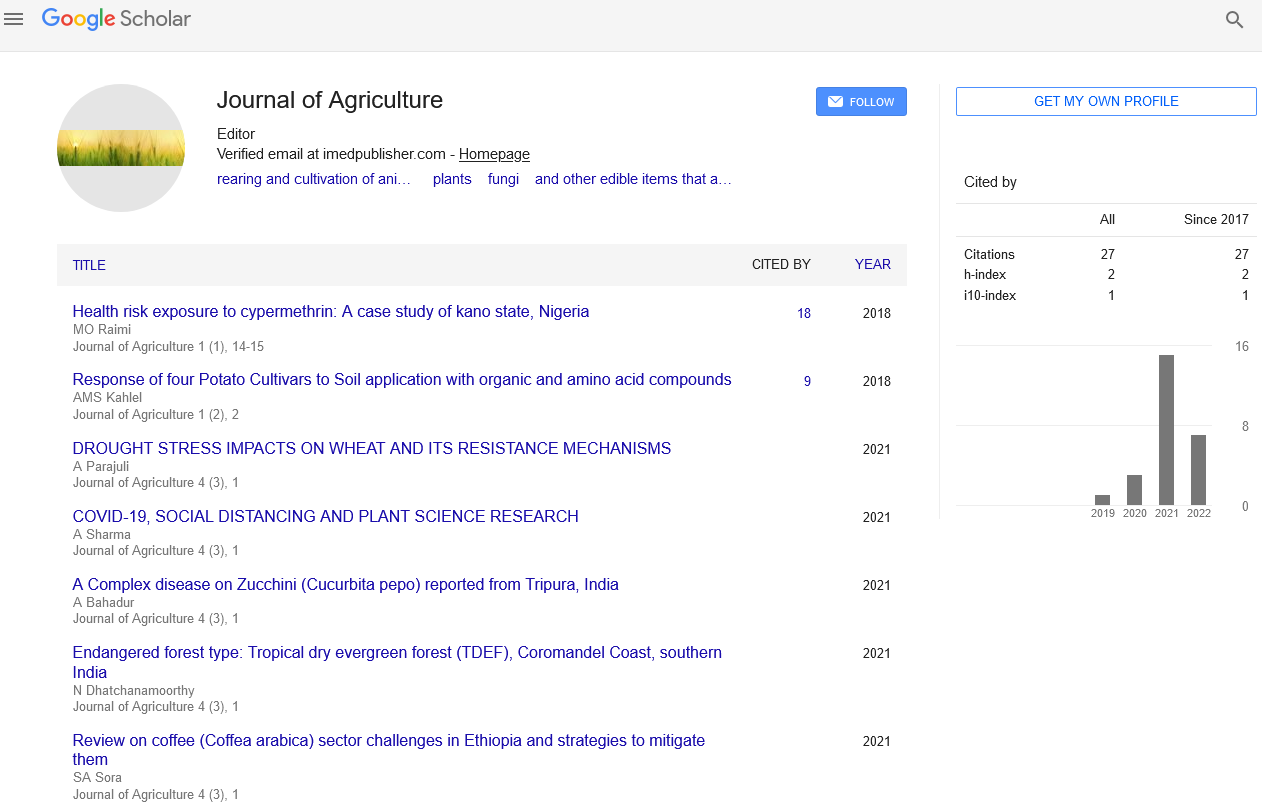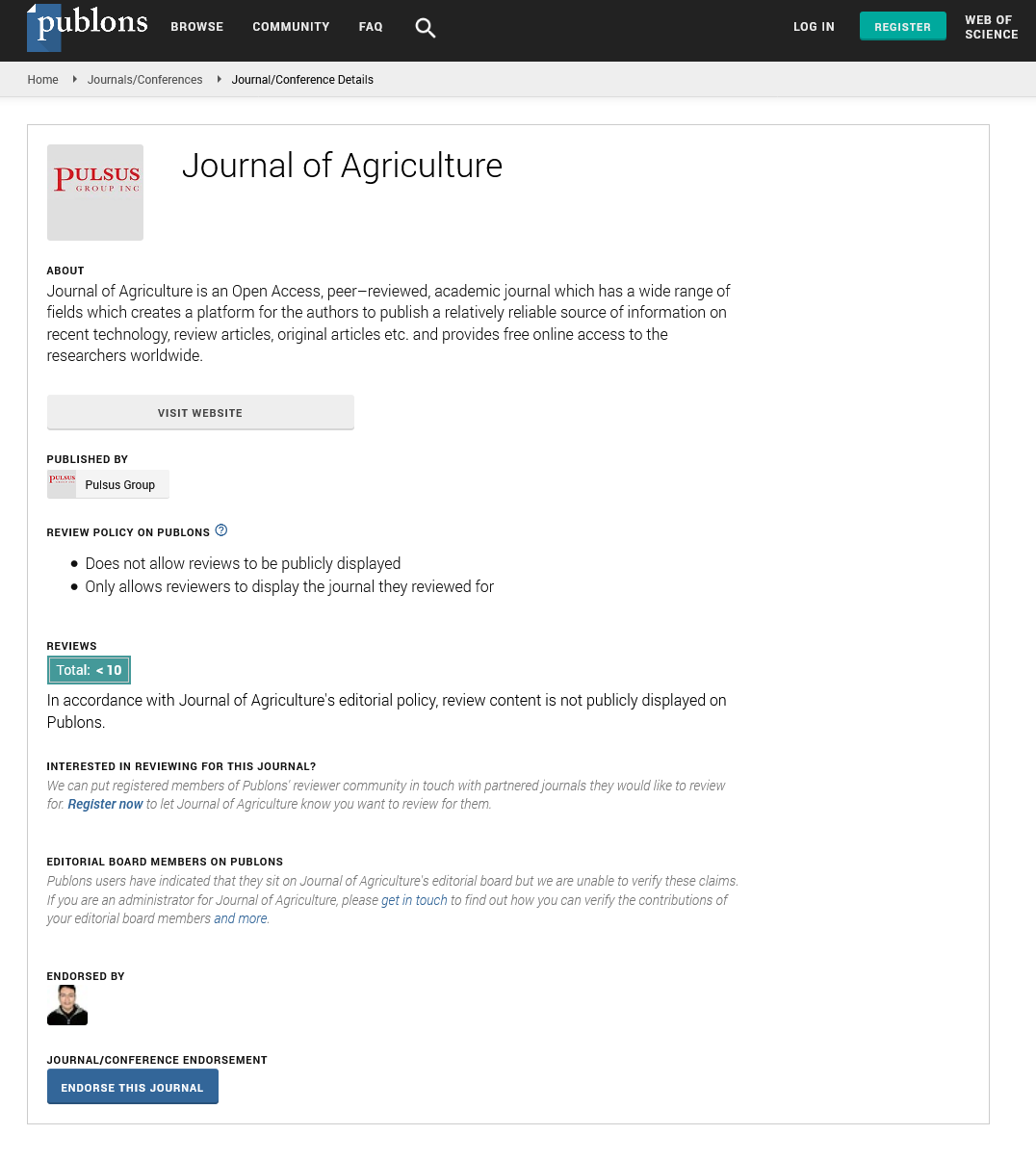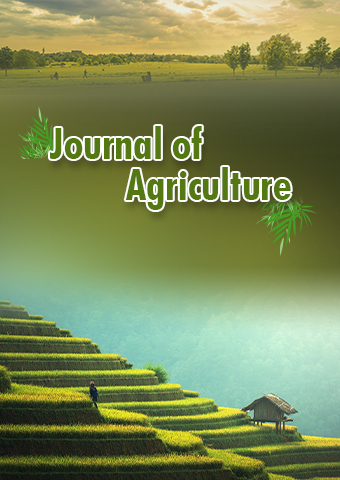Editorial - Journal of Agriculture (2023) Volume 6, Issue 1
A Short Note on Fish Farming
Dr. Arvaj Khan*
Department of Agriculture, University of HGT Science and Technology, Iran
Department of Agriculture, University of HGT Science and Technology, Iran
E-mail: arvaj.k@gamil.com
Received: 03-Feb-2023, Manuscript No. jagri-23-95381; Editor assigned: 06-Feb-2023, PreQC No. jagri-23-95381; Reviewed: 13- Feb-2023, QC No jagri-23-95381; Revised: 23-Feb-2023, Manuscript No. jagri-23-95381 (R); Published: 28-Feb-2023; DOI: 10.37532/ jagri.2023.6(1).14-16
Abstract
Fish farming, also known as aquaculture, is the practice of raising fish in tanks, ponds, or other bodies of water for commercial or recreational purposes. This method of farming has become increasingly popular in recent years as a way to meet the growing demand for seafood while reducing the strain on wild fish populations. Fish farming can provide a sustainable source of high-quality protein and other nutrients, and can also create jobs and stimulate economic growth in rural communities. However, there are also environmental and social challenges associated with fish farming, including water pollution, disease outbreaks, and ethical concerns about the treatment of farmed fish. As the global population continues to grow and demand for seafood increases, it is important to carefully consider the benefits and drawbacks of fish farming and work to develop sustainable and responsible practices for this industry. Fish farming has become increasingly popular in recent years due to its potential to provide a sustainable source of protein, create jobs, and support local economies. There are several different types of fish farming, including pond-based systems, cage-based systems, and recirculating systems. Pond-based systems are the most traditional form of fish farming, in which fish are raised in large outdoor ponds or tanks. Cage-based systems involve confining fish within netted enclosures in a body of water, such as a lake or ocean. Recirculating systems are closed-loop systems in which fish are raised in tanks, and the water is continuously recirculated and filtered.
Keywords
Fish farming • aquaculture • Nutrients • Environmental • Create jobs • Pond-based systems • water • Recirculating systems
Introduction
Fish farming has several advantages over traditional fishing methods. For one, it can help to alleviate pressure on wild fish stocks, which have been overfished in many parts of the world. Fish farming can also help to create jobs and support local economies, particularly in rural areas where traditional fishing may not be a viable option. Fish farming can also provide a more sustainable source of protein compared to other forms of animal agriculture [1].
Fish farming has emerged as a crucial tool in ensuring food security for the growing population. With the increase in demand for fish, traditional fishing methods are not sufficient to meet this demand. Fish farming, also known as aquaculture, has the potential to meet the increasing demand for fish and can also serve as an alternative livelihood for fishermen. Fish are more efficient at converting feed into protein than land-based animals such as cattle or pigs, meaning that they require less feed and produce less waste [2]. Additionally, fish farming can be done in a more controlled environment, which can help to minimize the use of antibiotics and other chemicals that are often used in traditional animal agriculture. Despite its many benefits, fish farming does come with some challenges. One of the biggest challenges is ensuring that the fish are raised in a healthy environment. Fish are susceptible to disease, and overcrowding in fish farms can lead to the spread of disease and parasites. Additionally, fish farms can have negative environmental impacts if not properly managed. Waste from fish farms can pollute waterways and contribute to the growth of harmful algal blooms [3].
To address these challenges, fish farmers must implement sustainable practices such as regularly monitoring water quality, managing fish populations to prevent overcrowding, and properly disposing of waste. Additionally, there is a need for ongoing research and development to improve the efficiency and sustainability of fish farming practices. Fish farming, also known as aquaculture, is the practice of rearing fish in controlled environments such as tanks, ponds, or cages [4]. The practice has been around for thousands of years and has become increasingly popular as a way to meet the growing demand for fish while reducing pressure on wild fish populations. Despite its numerous benefits, fish farming is not without its challenges. In this article, we will explore some of the difficulties associated with fish farming and how they can be addressed.
Despite its numerous benefits, fish farming is not without its challenges. In this article, we will explore some of the difficulties associated with fish farming and how they can be addressed [5].
Disease management
Fish are susceptible to various diseases, which can lead to significant losses for farmers. Diseases can be caused by bacteria, viruses, parasites, or environmental factors. In some cases, diseases can spread rapidly throughout a farm, leading to widespread mortality [6].
To prevent and control diseases, farmers must implement strict biosecurity measures, such as regular monitoring, testing, and disinfection of equipment and facilities. Additionally, farmers can use vaccines and antibiotics to treat sick fish and prevent the spread of disease [7].
Water quality management
Fish require clean water with optimal levels of dissolved oxygen, pH, and other parameters to survive and grow. Poor water quality can lead to stress, disease, and reduced growth rates. Maintaining good water quality is a critical aspect of fish farming. To ensure optimal water quality, farmers must monitor water parameters regularly and make necessary adjustments, such as adding oxygen or adjusting pH levels. Farmers can also use water treatment systems to remove pollutants and maintain water quality [8].
Feed management
Fish require a balanced diet that provides all the essential nutrients they need to grow and thrive. Feeding fish the wrong type or amount of food can lead to health problems, reduced growth rates, and increased mortality. To ensure proper nutrition, farmers must provide fish with highquality, species-appropriate feeds that meet their nutritional requirements. Additionally, farmers must carefully monitor feeding rates and adjust them based on factors such as water temperature, fish size, and growth rate [9].
Environmental impact
Fish farming can have negative impacts on the environment, such as water pollution, habitat destruction, and the spread of diseases and parasites to wild fish populations. These impacts can be reduced through the use of sustainable farming practices, such as minimizing waste and energy use, using natural or low-impact feeds, and controlling disease and parasite outbreaks [10].
Conclusion
Fish farming has become an essential aspect of the global food system. It provides an opportunity for farmers to earn a livelihood and offers a sustainable alternative to traditional fishing methods. It also offers the potential to reduce pressure on natural fish populations and can be an effective way to address food insecurity. However, fish farming must be carried out sustainably, with attention given to the environmental impact of farming practices. Therefore, it is crucial to invest in research to ensure that fish farming practices are environmentally sustainable, economically viable, and socially acceptable. By doing so, fish farming can continue to provide food security for future generations while protecting
References
- Beccuti G, Monagheddu C, Evangelista A et al. Timing of food intake: Sounding the alarm about metabolic impairments? A systematic review. Pharmacological Research. 125, 132–141 (2017).
- Anderson JW, Ward K. High-carbohydrate, high-fiber diets for insulin-treated men with diabetes mellitus. Am J Clin Nutr. 32, 2312-21 (1979).
- Booth FW, Chakravarthy MV. Physical activity and dietary intervention for chronic diseases: a quick fix after all. J Appl Physiol. 100, 1439-40 (2006).
- Beccuti G, Monagheddu C, Evangelista A et al. Timing of food intake: Sounding the alarm about metabolic impairments? A systematic review. Pharmacological Research. 125, 132–141 (2017).
- Anderson JW, Ward K. High-carbohydrate, high-fiber diets for insulin-treated men with diabetes mellitus. Am J Clin Nutr. 32, 2312-21 (1979).
- Booth FW, Chakravarthy MV. Physical activity and dietary intervention for chronic diseases: a quick fix after all. J Appl Physiol. 100, 1439-40 (2006).
- Roberts CK, Won D, Pruthi S et al. Effect of a short-term diet and exercise intervention on oxidative stress, inflammation, MMP-9, and monocyte chemotactic activity in men with metabolic syndrome factors. J Appl Physiol. 100: 1657-65 (2006).
- Chandalia M, Lutjohann D, von Bergmann K et al. Beneficial effects of high dietary fiber intake in patients with type 2 diabetes mellitus. N Engl J Med. 342, 1392-8 (2000).
- Schwartz SE, Levine RA, Weinstock RS et al. Sustained pectin ingestion: effect on gastric emptying and glucose tolerance in non-insulin-dependent diabetic patients. Am J Clin Nutr. 48, 1413-7 (1988).
- Reynolds A, Mann J, Cummings J et al. Carbohydrate quality and human health: a series of systematic reviews and meta-analyses. Lancet. 393, 434-445 (2019).
Indexed at, Google Scholar, Crossref
Indexed at, Google Scholar, Crossref
Indexed at, Google Scholar, Crossref
Indexed at, Google Scholar, Crossref
Indexed at, Google Scholar, Crossref
Indexed at, Google Scholar, Crossref
Indexed at, Google Scholar, Cross ref
Indexed at, Google Scholar, Crossref
Indexed at, Google Scholar, Crossref


